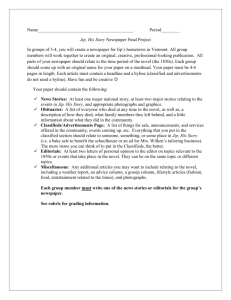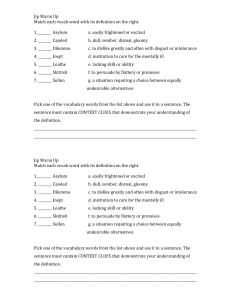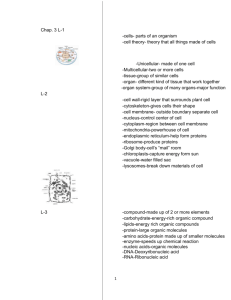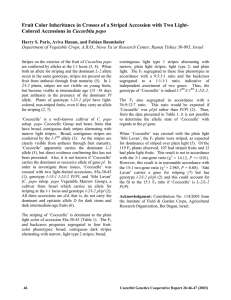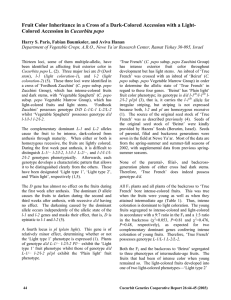Interaction of Three Loci, Reverse Stripe Phenotype in Egg Gourd l-1 Brent Loy
advertisement
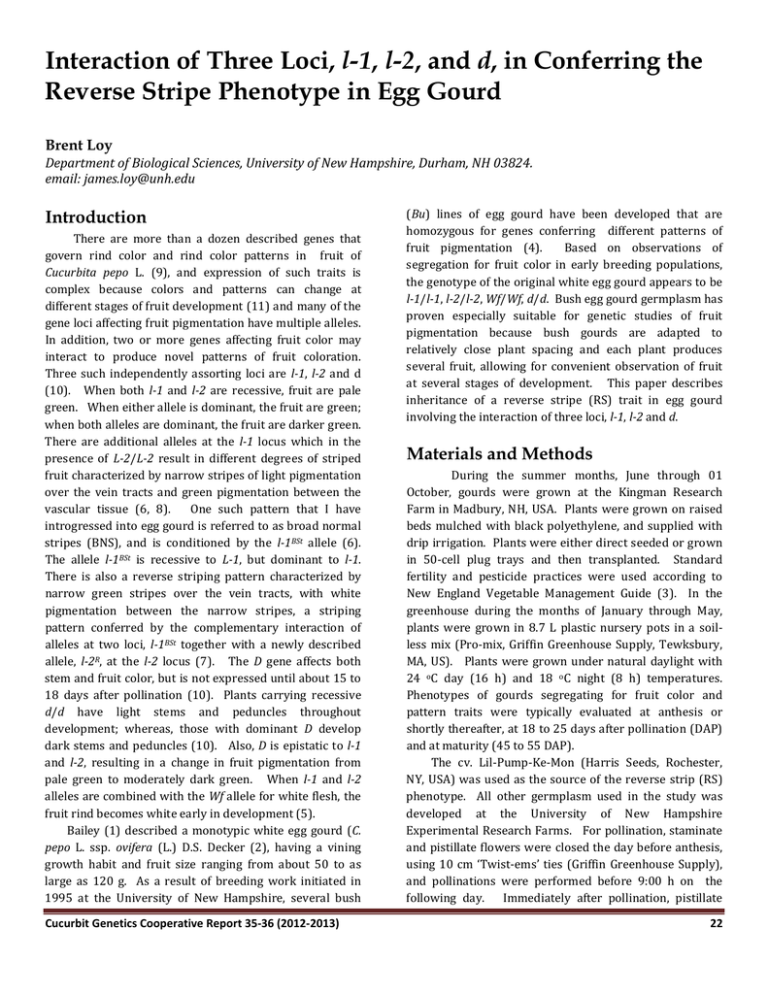
Interaction of Three Loci, l-1, l-2, and d, in Conferring the Reverse Stripe Phenotype in Egg Gourd Brent Loy Department of Biological Sciences, University of New Hampshire, Durham, NH 03824. email: james.loy@unh.edu Introduction There are more than a dozen described genes that govern rind color and rind color patterns in fruit of Cucurbita pepo L. (9), and expression of such traits is complex because colors and patterns can change at different stages of fruit development (11) and many of the gene loci affecting fruit pigmentation have multiple alleles. In addition, two or more genes affecting fruit color may interact to produce novel patterns of fruit coloration. Three such independently assorting loci are l-1, l-2 and d (10). When both l-1 and l-2 are recessive, fruit are pale green. When either allele is dominant, the fruit are green; when both alleles are dominant, the fruit are darker green. There are additional alleles at the l-1 locus which in the presence of L-2/L-2 result in different degrees of striped fruit characterized by narrow stripes of light pigmentation over the vein tracts and green pigmentation between the vascular tissue (6, 8). One such pattern that I have introgressed into egg gourd is referred to as broad normal stripes (BNS), and is conditioned by the l-1BSt allele (6). The allele l-1BSt is recessive to L-1, but dominant to l-1. There is also a reverse striping pattern characterized by narrow green stripes over the vein tracts, with white pigmentation between the narrow stripes, a striping pattern conferred by the complementary interaction of alleles at two loci, l-1BSt together with a newly described allele, l-2R, at the l-2 locus (7). The D gene affects both stem and fruit color, but is not expressed until about 15 to 18 days after pollination (10). Plants carrying recessive d/d have light stems and peduncles throughout development; whereas, those with dominant D develop dark stems and peduncles (10). Also, D is epistatic to l-1 and l-2, resulting in a change in fruit pigmentation from pale green to moderately dark green. When l-1 and l-2 alleles are combined with the Wf allele for white flesh, the fruit rind becomes white early in development (5). Bailey (1) described a monotypic white egg gourd (C. pepo L. ssp. ovifera (L.) D.S. Decker (2), having a vining growth habit and fruit size ranging from about 50 to as large as 120 g. As a result of breeding work initiated in 1995 at the University of New Hampshire, several bush Cucurbit Genetics Cooperative Report 35-36 (2012-2013) (Bu) lines of egg gourd have been developed that are homozygous for genes conferring different patterns of fruit pigmentation (4). Based on observations of segregation for fruit color in early breeding populations, the genotype of the original white egg gourd appears to be l-1/l-1, l-2/l-2, Wf/Wf, d/d. Bush egg gourd germplasm has proven especially suitable for genetic studies of fruit pigmentation because bush gourds are adapted to relatively close plant spacing and each plant produces several fruit, allowing for convenient observation of fruit at several stages of development. This paper describes inheritance of a reverse stripe (RS) trait in egg gourd involving the interaction of three loci, l-1, l-2 and d. Materials and Methods During the summer months, June through 01 October, gourds were grown at the Kingman Research Farm in Madbury, NH, USA. Plants were grown on raised beds mulched with black polyethylene, and supplied with drip irrigation. Plants were either direct seeded or grown in 50-cell plug trays and then transplanted. Standard fertility and pesticide practices were used according to New England Vegetable Management Guide (3). In the greenhouse during the months of January through May, plants were grown in 8.7 L plastic nursery pots in a soilless mix (Pro-mix, Griffin Greenhouse Supply, Tewksbury, MA, US). Plants were grown under natural daylight with 24 oC day (16 h) and 18 oC night (8 h) temperatures. Phenotypes of gourds segregating for fruit color and pattern traits were typically evaluated at anthesis or shortly thereafter, at 18 to 25 days after pollination (DAP) and at maturity (45 to 55 DAP). The cv. Lil-Pump-Ke-Mon (Harris Seeds, Rochester, NY, USA) was used as the source of the reverse strip (RS) phenotype. All other germplasm used in the study was developed at the University of New Hampshire Experimental Research Farms. For pollination, staminate and pistillate flowers were closed the day before anthesis, using 10 cm ‘Twist-ems’ ties (Griffin Greenhouse Supply), and pollinations were performed before 9:00 h on the following day. Immediately after pollination, pistillate 22 flowers were re-closed with Twist-ems, tagged with the date, and if necessary, covered with a poly mesh bag. Fruit were harvested 50 to 60 DAP, and the seeds were subsequently removed, cleaned, and dried at 30 oC in a forced air dryer. Results and Discussion Beginning in 2004, a RS trait derived from an ornamental pumpkin, ‘Lil-Pump Ke-Mon’, was introgressed into egg gourd germplasm (4). By spring of 2009, two related RS bush egg gourd lines, G1213F6 and G1219F6, had been selected. However, both lines were segregating for reverse stripe and white fruit in a 3:1 ratio. Further selfing produced line G1213-1W, homozygous for white fruit, and line G12194-3, homozygous for the RS trait. The white-fruited line displayed ghost stripes in the form of narrow white stripes over slightly raised vein tracts, with the intervening wider stripes being slightly off-white. Lines with this phenotype were identified and genotyped earlier in the NH breeding program, and are designated as wh/wh BNS, with the genotype l-1BSt/l-1BSt, l-2/l-2. Prior to spring of 2010 it was assumed that the genotype of the RS lines was l-1BSt/l-1BSt, l-2R/l-2R, according to inheritance of the RS trait reported by Paris (7). Crosses of the RS line to a green-fruited line, G344-22 (L-1/L-1, L-2/L-2), and to a BNS line, G424-25-3-11 (l-1BSt/l-1BSt, L-2/L-2) produced F1 plants with intermediate reverse striping, narrow green and wide mottled green and white stripes, results expected for plants heterozygous for the semi-dominant l-1R allele. Intermediate reverse striping in the two F1s differed; plants with the L-1/l-1BSt genotype had very narrow green stripes (Fig 1C); whereas, plants homozygous for l-1BSt had wider, more prominent green stripes (Fig. 1B). A cross of G1213-1W to G424-25-3-11 produced BNS F1 plants with narrow white and wide light green stripes, results expected for BNS plants heterozygous (L-2/l-2) at the l-2 locus. Unexpectedly, however, F1 plants derived from G1213-1W x G344-22 and having the genotype L-1/l-1BSt, L-2/l-2 produced intermediate RS fruit identical to fruit derived from the cross of 344-22 to the RS line G12194-3. These results suggested that another dominant gene was involved in reverse striping in egg gourd. A small testcross population was grown during the summer of 2010, resulting from a cross of a wh/wh BSN line (G424-10-1) x an intermediate RS F1 plant (G424-25-3-11 x G1219-4). If RS was due to the l-2R allele, there should have been 1:1 segregation for intermediate RS (l-1BSt/l-1BSt, l-2R/l-2) and white/green BNS (l-1BSt/l-1BSt, L-2/l-2). However, in a population of 43 plants, 10 were wh/wh BNS, 13 were gray or white/green BNS, 10 were RS and 10 were intermediate RS, a testcross ratio suggesting segregation of Cucurbit Genetics Cooperative Report 35-36 (2012-2013) two loci (L-2/l-2 and a dominant gene conferring RS), and indicating that G1219-4 carries a dominant allele conferring RS in combination with homozygosity for l-2 and l-1BSt. Additional backcross and F2 populations were generated in 2010 and 2011 from G1219-4, G1213-1W, G424-25-3-11 and G344-22 which indicated that RS plants were homozygous for l-1BSt and l-2, and carried an additional dominant gene that conferred reverse striping. However, results were difficult to interpret because of deficiencies of green progeny, an excess of progeny showing an intermediate RS phenotype, and in certain populations, variability in expression of BNS patterns. Fortuitously, in spring of 2012 it was observed that stems and peduncles of the wh/wh BNS line (G1213-1W) were light green (d/d; Fig. 1F), and stems of F1 RS plants resulting from a cross of the white fruited line G212-349 (l-1/l-1, l-2/l-2, d/d) to the RS line 121943-4 (l-1BSt/l-1BSt, l2/l-2) were dark green, indicating that the RS line was homozygous for the D gene (4). A later planting in spring of 2012 revealed that G424-25-3-11 plants have light peduncles (Fig. 1E), whereas G344-22-1 (Fig. 1D) and G121943-4 (Fig. 1A) plants have dark peduncles (D/D), suggesting that the ‘D’ allele was the dominant factor contributing to the reverse stripe trait. As a result of observations on the association of stem color with striping phenotypes, we made appropriate crosses with the breeding material that was on hand in the greenhouse to further test the hypothesis that l-1BSt and l-2 act in a complementary manner with the dominant D gene to produce reverse striping, and to obtain a better understanding of the genetics of broad normal striping (BNS) patterns. In addition, we had remnant seed of (G1213-1W x G1219-4). The F2 population derived from G1213-1 x G1219-4 segregated 3:1 (19:7) for RS/dark stem and wh/wh BNS/light stem progeny, corroborating that dominant D together with recessive l-1BSt and l-2 alleles confers reverse striping. Two populations were grown in summer of 2012 that were segregating for l-1 versus l-1BSt and D versus d, but homozygous for l-2 (Table 1). The RS phenotype is not fully expressed until about two weeks after pollination (Fig. 2) coinciding with the delayed expression of D on stem pigmentation (10). Therefore, data on reverse striping were not taken until several fruit had reached at least 15 to 18 DAP. The F2 population (G12-3) segregated 3:1 for D/_ (54) versus d/d (16). All reverse stripe plants had dark stems and the proportion of RS progeny was consistent with the expectation that plants with either the l-1BSt/l-1 or l-1BSt/l1BSt genotypes in combination with the D gene displayed the RS phenotype. Plants with green fruit also had dark 23 stems, and the proportion of progeny with green fruit was consistent with the expectation that the D gene was epistatic to l-1 and l-2 (10), producing green fruit in plants homozygous for l-1 and l-2 alleles. In the second population, G12-5, there was 1:1 segregation of D/_ (41) versus d/d (44) as expected, and the segregation of RS, green and white fruit fit the expected 3:1:4 model (χ2 P = 0.23). In crosses, involving segregation for L-1/l-1BSt, L-2/l-2, and D/d, solid green fruit are only produced when L-2 is homozygous. Various degrees of intermediate reverse stripe fruit are produced with the following genotypes: L1/L-1, L-2/l-2, D/_; L-1/l-1BSt, L-2/l-2, D/_; l-1BSt/l-1BSt, L2/l-2, D/_, and L-1/L-1, L-2/l-2, d/d. An example of different degrees of intermediate RS striping in a backcross population segregating 1:1 (44:41) for intermediate RS striping (L-1/L-1, L-2/l-2, L-1/l-1BSt, L-2/l2 and) and green fruit (L-1/L-1, L-2/L-2 and L-1/l-1BSt, L2/L-2) is shown in Fig. 3. Conclusions 1. 2. In egg gourd, reverse striping is conferred by complementary interaction of the D allele, and homozygous l-2 alleles with either l-1BSt/l-1BSt , L-1/l1BSt or l-1BSt/l-1 allelic combinations. Several genotypes, but most noticeably those heterozygous for L-2/l-2 in the presence of the D allele and either L-1/L-1, L-1/l-1BSt or l-1BSt/l-1BSt, can produce intermediate reverse stripe phenotypes characterized by narrow green stripes over the vein tracts and various degrees of mottled white and green wide striping between vein tracts. Cucurbit Genetics Cooperative Report 35-36 (2012-2013) Acknowledgements This work was supported by Hatch Grants from the NH Agricultural Experiment Station. Literature Cited 1. Bailey, L.H. 1937. The garden of the gourds. MacMillan, New York (US). 2. Decker, D.S. 1988. Origin, evolution, and systematics of Cucurbita pepo (Cucurbitaceae). Econ. Bot. 42:4-15. 3. Howell, J.C. 2006-2007. New England Vegetable Management Guide. Univ. Massachusetts Extension Office of Communication. 4. Loy, J.B. 2012. Introgression of genes conferring the bush habit of growth and variation in fruit rind color into white nest egg gourd, pp. 275-282. In: N. Sari, I. Solmaz, and V. Aras (eds.), Cucurbitaceae 2012 Proceedings, Adana, Turkey, Ҫukurova University. 5. Paris, H.S. 1995. The dominant Wf (white flesh) allele is necessary for expression of white mature fruit color in Cucurbita pepo, pp. 219-220. In G. Lester and J. Dunlap (eds): Cucurbitaceae 1994, Gateway, Edinburg, Texas (US). 6. Paris, H.S. 2000. Gene for broad, contiguous dark stripes in cocozelle squash. Euphytica 115:191-196. 7. Paris, H.S. 2009. Genes for “reverse” fruit striping in squash (Cucurbita pepo L.). J. Hered. 371-379. 8. Paris, H.S. and Y. Burger. 1989. Complementary genes for fruit striping in summer squash. J. Hered. 80:490493. 9. Paris, H.S. and E. Kabelka. 2008-2009. Gene list for Cucurbita species, 2009. Cucurbit Genet. Coop. Rep. 31-32:44-69. 10. Paris, H.S and H. Nerson. 1986. Genes for intense fruit pigmentation of squash. J. Hered. 77:403-409. 11. Shifriss, O. 1949. A developmental approach to the genetics of fruit color in Cucurbita pepo L. J. Hered. 40:232-241. 24 Table 1. Inheritance of the reverse stripe trait in egg gourd, based on segregation in two populations homozygous for l-2: (1) G12-3, an F2 population derived from crossing a white line, G212-349 (l-1/l-1, l-2/l-2, d/d) x a reverse stripe line, G12194-3 (l1BSt/l-1BSt, l-2/l-2, D/D), and (2) G12-5, a population created by crossing two F1 plants, G212-349 x G2123-1W (l-1BSt/l-1, l-2/l2, d/d) x G212-349 x G12194-3 (l-1BSt/l-1, l-2/l-2, D/d). Parental population G12-3 G12-5 Distribution of phenotypesz RS/dk st Gr/dk st Wh/lt st 45 11 16 26 15 44 Expected ratio 9:3:4 3:1:4 χ2 0.88 2.97 P 0.64 0.23 ZRS/dk – reverse stripe, dark stem; Gr/lt st = green, dark stem; Wh/lt st = white, light stem. White class included l-2/l-2, d/d plants carrying either l-1 or l-1BSt alleles; reverse stripe class included two genotypes, L-1/l-1BSt, D/_ and l-1BSt/l-1BSt, D_; and green class was l-1/l-1/D/_. Fig. 1. Different striped phenotypes and genotypes for egg gourd lines and selections. A = reverse stripe (RS; l-1BSt/l-1BSt, l-2/l2, D/D), B = RS wide intermediate (l-1BSt/l-1BSt, L-2/l-2, D/_); C = RS narrow intermediate (L-1/l-1BSt, L-2/l-2, D/_); D = green (L1/L-1, L-2/L-2, D/D),; E = broad normal stripe (BNS; l-1BSt/l-1BSt, L-2/L-2, d/d); F = wh/wh BNS (l-1BSt/l-1BSt, l-2/l-2, d/d). Cucurbit Genetics Cooperative Report 35-36 (2012-2013) 25 Fig. 2. Transition to reverse striping during development of egg gourd, expressed as days after pollination (DAP). Fig. 3. Variability in intermediate reverse striping in a population derived from G344-22 x (G1213-1W x G344-22), segregating 1:1 for green fruit (L-1/L-1, L-2/L-2 or L-1/l-1BSt, L-2/L-2), represented by four fruit on right, or intermediate RS fruit (L-1/L-1, L-2/l-2 or L-1/l-1BSt, L-2/l-2). Plants were either D/D or D/d. Cucurbit Genetics Cooperative Report 35-36 (2012-2013) 26
